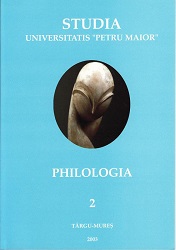Williams Carlos Williams - Cubism and Poetry
Williams Carlos Williams - Cubism and Poetry
Author(s): Ramona-Gabriela HosuSubject(s): Language and Literature Studies
Published by: Editura Universităţii Petru Maior
Summary/Abstract: In 1913, an international exhibition held in New York at the Sixty - Ninth Regiment Armory, known as the “Armory Show”, revealed the gap between American artists and French avant-garde painting. With WW I, some of the European avant-gardists began to migrate to the USA and at least two names are suggestive: Francis Picabia and Marcel Duchamp. In 1917 Duchamp helped organize an exhibition of modern art following the European practice of independent exhibitions that showed the work of artists rejected by the state-supported academies. Any artist would be allowed to exhibit works. There was to be no jury to select the works and thus impose its taste upon the exhibition. Duchamp tested the principles of the organizing committee by submitting to the exhibition a porcelain urinal entitled Fountain and signed it “R. Mutt”, who was a famous Manhattan plumber at the time. The organizing committee rejected the entry and Duchamp resigned from the committee and issued a manifesto in defense of his gesture. An artist, having selected the artifact, made the urinal be art. He said: “the only works of art America has given are her plumbing and her bridges” (Williams, apud Tashjian in Luedtke, 1992: 155). He meant that Americans, with their commitment to technology, were creating art all along but did not know it. Duchamp’s Fountain called distinctions like fine art & craft, high & low art or fine art &commercial art into question. At the time, conservative American artists considered the selection of a urinal for an art exhibition scandalous. Yet Duchamp’s gesture suggested the possibility that mass-produced objects, products of machine technology, might posses an aesthetic dimension even though such objects had been overlooked as art. As a consequence, Duchamp’s observation about American bridges and plumbing might be a validation of some artifacts for their aesthetic qualities previously ignored.
Journal: Studia Universitatis Petru Maior. Philologia
- Issue Year: 2003
- Issue No: 02
- Page Range: 117-122
- Page Count: 6
- Language: English

